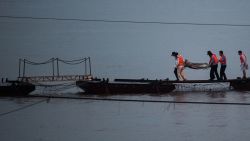Story highlights
NEW: Chinese state media: 66 found dead, 14 rescued and hundreds still missing
Rescuers are cutting holes in hull of the ship but haven't found signs of life
Search of riverbanks extended more than 135 miles downstream on Yangtze River
With hopes fading of finding survivors, Chinese rescuers are cutting holes in the hull of the capsized cruise ship in the Yangtze River.
So far, they haven’t found any signs of life. More than 370 people remain missing more than two and half days after the ship, the Eastern Star, overturned during a storm.
The number of dead bodies recovered from the wreck continues to mount. As of Thursday morning, it stood at 66, according to state media.
Only 14 survivors have been found, a total that hasn’t increased since Tuesday, the day after the ship went down with more than 450 people aboard.
Rescue teams have cut at least one hole in the hull, which is sticking out of the water, and are working on three others to give divers new routes into parts of the upturned ship, Chinese state broadcaster CCTV reported.
But if anyone inside the ship is still alive at this point, they would be pushing the limits of human endurance.
In 2013, a 29-year-old man was reported rescued after spending 60 hours – 2½ days – in an air pocket in a boat off the coast of Nigeria.
The Chinese ship is already past that point. Many of the people on board it were in their 60s and 70s.
Relatives of some of the passengers have tried to make their own way to the site of their disaster, expressing anger at the official response.
Tornado as a cause?
A tornado that lasted 15 to 20 minutes happened Monday around the same time the riverboat sank, the Chinese Meteorological Administration said, giving credence to accounts from the boat’s captain and chief engineer that a twister hit the vessel.
Ship sinks in China's Yangtze River
CNN meteorologist Brandon Miller said there’s no way to know for certain if a tornado occurred because U.S. forecasters don’t have radar access, but they can see satellite data that showed a strong thunderstorm in the area of the ship. That storm could have produced a tornado, he said.
The captain and chief engineer have both been taken into police custody for questioning after surviving the disaster.
The Chinese Meteorological Administration gave the tornado a preliminary rating of at least EF-1 on the Enhanced Fujita scale, which classifies tornadoes based on wind damage. An EF-1 storm packs winds between 86 mph and 110 mph. The tornado that struck on the day of the sinking was less than 1 kilometer wide, the administration said, according to state media.
Satellite information from a website run by the Transportation Ministry shows the ship suddenly changing direction a matter of minutes before authorities say it sank.
It wasn’t clear what caused the ship to start moving downstream rather than upstream. It’s possible that the change in direction came after the ship was left disabled and drifting by the storm.
Combing the river
Divers have been plunging into the polluted, sediment-laden waters of the Yangtze and finding their way inside compartments of the vessel.
Another rescue team has been looking along the Yangtze for people who got swept away by currents. The search of the riverbanks, authorities said, has now been extended more than 220 kilometers (135 miles) downstream.
A diver who found somebody alive Tuesday stressed the lack of visibility inside the wreck.
“I swam back and forth three times. And by the third time, I felt somebody was there above me,” Guan Dong told Chinese state-run broadcaster CCTV. “As soon as I got out of the water, I noticed the trapped victim, it was pitch-dark with just him inside the cabin and nobody else.”
Experts said the divers face a dangerous challenge.
“Just trying to get into the vessel is going to be difficult and let alone trying to explore the ship,” Capt. Gregg Baumann, director of diving for the U.S. Navy, told CNN. “And for divers who’ve probably never been in the ship before, going into the ship for the first time, and you can’t see. You’re going in hand over hand.”
Previous compliance issues reported
The Eastern Star apparently had problems complying with maritime standards two years ago.
According to a document on the Nanjing Maritime Bureau’s website, the Eastern Star and five other tourist vessels were impounded in 2013, and the issues were reported to the Chongqing Maritime Safety Administration, where the ships were registered. The document, however, did not say how long the ships were detained or what issues were involved.
The Nanjing bureau recommended that its counterpart in Chongqing strengthen its management to ensure safe navigation.
Details have emerged of the terrifying situation as the ship ran into trouble Monday night.
Most of the passengers on the Eastern Star had gone to bed when a violent storm struck and rain pounded the windows with such force that water seeped into the cabins, survivor Zhang Hui told China’s official news agency Xinhua.
The ship overturned so quickly that Zhang, a tour guide from Shanghai, had only had 30 seconds to grab a life jacket and get out of his cabin, he said.
CNN’s David McKenzie reported from Jianli County, and Jethro Mullen and Steven Jiang reported from Hong Kong. CNN’s Shen Lu, Brian Todd, Pamela Boykoff, Kevin Wang, Elizabeth Joseph, Don Melvin and Junko Ogura contributed to this report.
































